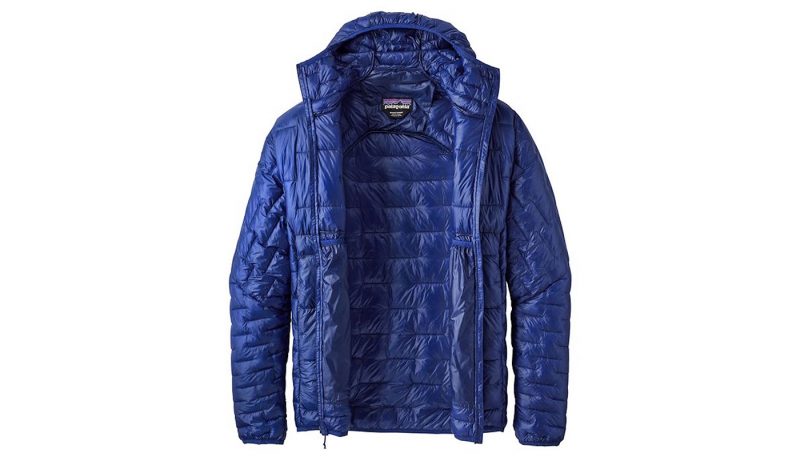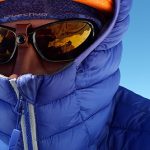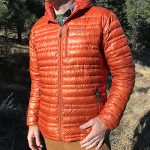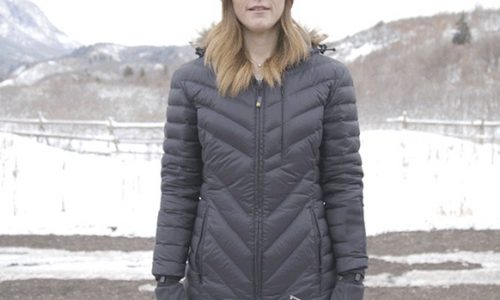Home » Gear Reviews » Hiking & Camping » Jackets » Insulated Jackets » Patagonia Micro Puff Hoody
Patagonia Micro Puff Hoody Review
July 24, 2018

















 87
87 The Good
- Lightweight
- Warm
- Packable
- Fit
- Water Repellency
The Bad
- Shell-stitch integrity
- Wind resistance
- Hood size
Materials
Patagonia developed the 100% polyester PlumaFill to pack the Micro Puff Hoody with a super lightweight synthetic insulation that packs very quickly and rebounds almost instantly when unleashed from its stuff pocket. It fulfills its promise of staying warm when subjected to the type of temporary moisture a jacket in this category would commonly experience—wet snow, tent condensation, surprise rain, etc.
A ripstop nylon used by several brands, a 10-denier Pertex Quantam, was chosen as the shell material to encase the innovative insulation. This specific ripstop product is often used to accompany insulating jackets because its minute thread size helps trap air, aiding a jacket’s ability to keep a person warm. The shell is also coated with a DWR finish.
Weatherproofness
The Patagonia Micro Puff Hoody performed as well as the Black Diamond First Light Hoody in keeping its tester warm when things got wet. It’s not quite as tough against wind, however. The hood snugs comfortably around the head, even with a climbing helmet, and the cuffs stayed in place and proved to be the ideal length for a medium-build, 170-lb tester.
The collar zips above chin level and the hood dropped to just above the tester’s eyebrows to reduce face exposure.
In lieu of hem tighteners, Patagonia employed an elasticized band of material to minimize wind and cold from entering at the waistline. It did so adequately, but isn’t as effective as a drawcord—clearly a weight-conscious design decision.
Temperature Control
While very light and innovative, the Micro Puff Hoody is first and foremost a jacket designed to keep a person safe from cold. Patagonia assembled the Pertex Quantum shell in a new way, developing a patent-pending quilt pattern that reportedly does a superior job in controlling the movement of insulation when compressed, or after several washes and prolonged use.
Instead of continuous stitching, the technique repeats a pattern of staggered, stand-alone stitch-lines. As a result, this is a very warm jacket, especially given its size and intended use cases. While hard to judge the movement of insulation in practical testing, testers felt safe in saying, “It must work, because this thing is warm.”
The hood prevented heat from leaving the head, and the coat’s fit though the core and underarsm allowed for heavier baselayers, furthering reasons to include this piece when heading into possibly burly alpine environments. One tester left his shell off while winds kicked-up during an in-bounds hike, and also as a primary insulator during an hours-long outdoor avalanche education course on northern California’s Donner Summit.
The handwarmer pockets are large enough to accept hands with mittens, and but proved somewhat bulky for unprotected hands. The weight goals of the coat prevented Patagonia from including a soft polyester or brushed fabric inside the pockets, but their size does allow for pockets of warm air to circulate within them.
Fit/Comfort
This is the best midlayer in the test, offering a true-to-size fit that isn’t overly “trim” and not at all bulky. Moreover, the 10-denier Pertex Quantum is very soft to the touch, and allows shells and bigger insulators to slide on and over with nary a snag. Its primary tester commented that the Micro Puff Hoody “floats” on the wearer, and in no way hinders movement or creates tight spots.
The hood won’t accept all helmets under it, yet it’s materials and unique stitching did seem to keep the PlumaFill in place and functional when tucked under the helmet. The tester commented that the hood’s effectiveness under a helmet can replace a beanie.
Features
The Micro Puff Hoody is a truly minimalist jacket, lacking anything superfluous. There are two handwarmer pockets, one of which serves as an on-board stuff sack. There are two, elasticized interior drop pockets, elastic around the cuffs, hood, and hem, and strips of fabric behind each side of the zipper that “merge” when closed to reduce wind and moisture from entering.
If construction is a feature, Patagonia should consider the durability of its stitching, as several strands began to “fly” loose during testing, namely around the outside pockets. It packs into and deploys quickly from its stuff-pocket, making it exceptionally portable.
Guide, writer, Truckee local, pub trivia host, and inventor of TripTarp®, Craig Rowe is the Gear Institute's chief stove and insulated jacket tester.



















No reviews have been posted for this product.
Use this gear?
Join Gear Nation and leave a review!
Create an Account